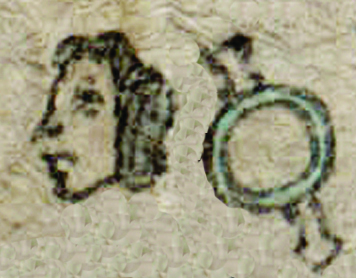Yaotl (BMapM86)
This black-line drawing of the simplex glyph for the personal name Yaotl (“Combatant”) is attested here as a man’s name. The glyph shows a round war shield with a turquoise blue border. Behind the shield is a macuahuitl, an obsidian blade-studded club, which was a weapon. These were symbols for combat.
Stephanie Wood
Many men had the name yaotl, which might not be surprising given the value placed upon warriors in the culture. A shield alone could also stand for yaotl. And, given that ayotl (turtles) had shield like shells on their back, it is not surprising that some yaotl signs have turtle-like characteristics. The ayotl might also have been a clandestine way to disguise the warlike sense of the name in the face of disapproving clergy.
Stephanie Wood
This glyph is not glossed; the transliteration of the glyph comes from Gordon Whittaker’s contribution to the study by Mary E. Miller and Barbara E. Mundy (2012).
c. 1565
Jeff Haskett-Wood
escudos, macanas, guerra, conflictos, combatientes, nombres de hombres

yao(tl), combatant, https://nahuatl.wired-humanities.org/content/yaotl
Combatiente
Stephanie Wood
Beinecke Map/Codex Reese, section 8, no. 86 in the Whittaker study (published in the Miller/Mundy book, 2012), and see the original at: https://brbl-dl.library.yale.edu/vufind/Record/3600017
The Bodleian Libraries, University of Oxford, hold the original manuscript, the MS. Arch. Selden. A. 1. This image is published here under the UK Creative Commons, “Attribution-NonCommercial-ShareAlike 3.0 License” (CC-BY-NC-SA 3.0).






